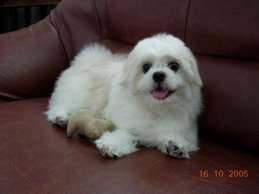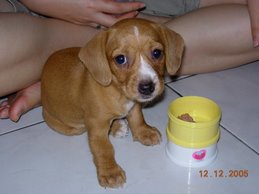Article From SubmitYOURArticle.com: Newfoundland Dog Breed Profile
Description: The Newfoundland is a large, massive
dog of immense strength. It is said to be even
stronger than such dogs as the Great Dane and
English Mastiff. The Newfoundland dog measures
27 to 29 inches at the withers, with the bitch 2
inches less. The male will weigh 130 to 150 (or
more) pounds with the female weighing 100 to 120
pounds. The Newfoundland has a long, heavy,
water-proof coat that is usually black, but
sometimes brown or grey. The feet of this dog
are webbed, to aid in swimming, as it is a dog
that loves the water. The Newfoundland usually
lives for only 8 to 10 years. It is also called
the Newf or the Newfie.
History: The Newfoundland had its beginnings in
Newfoundland, Canada. It is believed to be
descended from an indigenous dog, the St. John's
Water Dog, and the black bear dog that the
Vikings brought to the New World with them. It
is known, that whatever its early ancestry, it
did cross with Mastiffs brought over by fishermen
from Portugal. Used to help the fishermen, the
Newfoundland would haul in heavy nets and help
bring boats to shore. This dog has excelled in
rescuing people from the water and is powerful
enough to swim in heavy tides and high waves.
The Lewis and Clark Expedition was accompanied by
Lewis' Newfoundland, Seaman.
Temperament: The Newfoundland is justly famous
not only for its strength, but also for its
loving and gentle disposition. This is a calm
dog that is quiet in the house. The Newfoundland
is very good with children, although some care
should be exercised because of the dog's great
size. It is very loyal and devoted to its family
and is easy to train. This dog is not likely to
initiate a biting attack with an intruder, but
will content itself with holding the person or
positioning itself between the intruder and its
family. This is a Mastiff breed characteristic.
The Newfoundland will get along without problems
with other household dogs or other pets.
Health Issues: The Newfoundland can be subject to
hip and elbow dysplasia. This breed can also
develop bladder stones, which will usually have
to be removed surgically. The most serious
health problem is subvalvular aortic stenosis, a
serious heart condition that can affect even
young dogs. As with most large dogs, the
Newfoundland can be stricken with bloat. A quiet
time after small meals can help prevent this, but
if it does occur, the dog must be taken to a
veterinarian immediately to save its life.
Grooming: The thick coat of the Newfoundland must
be carefully brushed every week. During the
spring shed, the heavy undercoat must be brushed
out. The volume of hair produced will often be
astounding, almost taking up as much space as the
dog itself. The dog should not be shampooed as
this might remove the oils that contribute to the
waterproof coat.
Living Conditions: While it is said that the calm
and gentle Newfoundland can live in an apartment,
the size of the dog and the fact that it prefers
cold temperatures should provoke thought. This
dog will probably be best suited to living in a
house with a yard. While not the most active
dog, the Newf does need daily exercise. This dog
bonds strongly with its human friends and does
best and is happiest when with its family. A
family that enjoys outdoor activities, especially
those involving water will probably be the best
owners for this dog. Fishermen or hunters or
people engaged in winter sports will find this
dog a perfect companion.
----------------------------------------------------
For more information on Newfoundland Dog Breed,
Dog Training methods and Teacup Puppies for sale
including Yorkies, Chihuahuas and Morkies Please
visit my website below.
http://www.scottspuppypalace.com
EasyPublish this article: http://submityourarticle.com/articles/easypublish.php?art_id=89558














.jpg)






.jpg)

0 comments:
Post a Comment